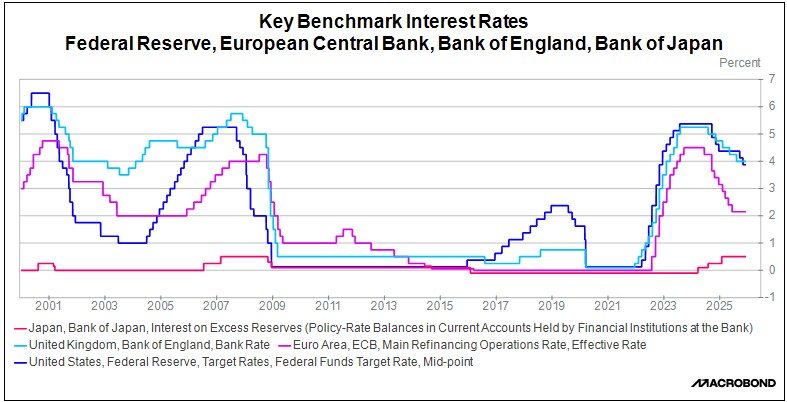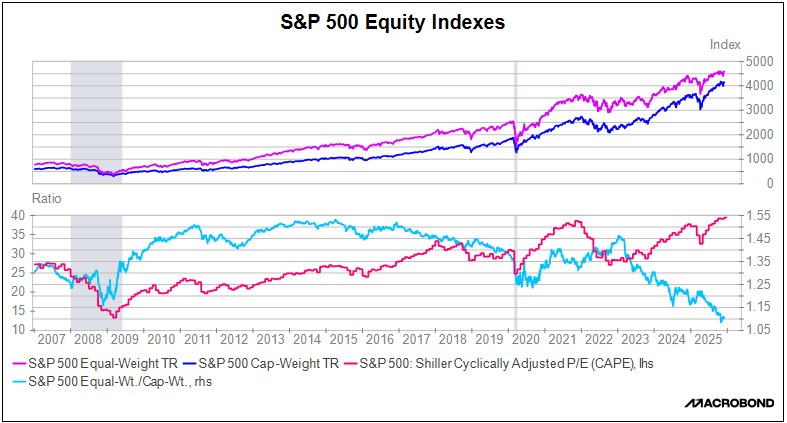by Patrick Fearon-Hernandez, CFA, and Thomas Wash
[Posted: 9:30 AM ET] | PDF
Our Comment begins with our examination of growing concerns for an AI bubble. We then provide an update on the strategic dynamics of the Ukraine conflict. The analysis continues with key market-moving stories, including reappointment of Federal Reserve governors, corporate partnerships to build supply chains independent of China, and the Bank of Japan’s hawkish policy shift. Finally, we include a roundup of essential domestic and international data releases to monitor.
Tech Tight Rope: Investor sentiment in the tech sector is fragile, underscoring the high tension between the AI boom’s potential and inherent risks. Broadcom’s earnings fueled this pessimism as its $75 million order backlog missed analyst targets. The company further created uncertainty by withholding 2026 guidance. This disappointment amplified earlier concerns raised by Oracle. The software giant reported weak earnings alongside accelerated capital spending plans, sparking doubts about Oracle’s long-term debt servicing capacity.
- Since October, the market has been plagued by valuation anxieties. This sentiment shift stems from a growing body of evidence indicating that widespread AI adoption is progressing much more slowly within firms than originally anticipated. The resulting disconnect between lofty stock prices and the actual speed of business integration has led investors to scrutinize whether companies can deliver the earnings growth required to sustain their elevated stock valuations.
- This shift has been evident in recent market performance as small and mid-cap stocks have demonstrated strong outperformance relative to their large cap counterparts during this period. Simultaneously, the Health Care sector, which contended with headwinds for much of the year, has generated the majority of its annual gains over the last three months, underscoring the market’s rediscovered appetite for defensive value.
- We maintain the view that AI momentum still has room to run, but we strongly recommend investors broaden their portfolio exposure beyond concentrated growth sectors. Adopting this strategy of diversification will serve to mitigate potential downside risk stemming from any future setbacks or valuation concerns within the AI sector.
Ukraine-Russia Peace Deal? While there appears to be momentum toward ending the conflict, the White House is reportedly struggling to secure unified support for a proposed peace deal. Reports emerged earlier this week that US officials are pressing Ukrainian President Volodymyr Zelensky to agree to a deal with Russia by Christmas. The main sticking point is reportedly the White House’s push for Ukraine to accept territorial concessions in exchange for unspecified security guarantees.
- The European Union is deeply skeptical of the peace deal, fearing Russia’s broader territorial ambitions in Europe. NATO’s leader recently stated that Russia is back in the “empire building business,” while provocations, such as surveillance balloons from Belarus drifting into Lithuania that forced it to shut its airspace and declare a state of emergency, continue.
- In order to calm fears, the White House does plan to offer some security support for Ukraine. It has been suggested that the assistance would come in the form of intelligence or possibly even air support; however, the administration has stated that it is still negotiating between the two sides.
- While Ukraine has succeeded in resisting Russia’s full-scale invasion, Moscow has secured incremental territorial gains that have weakened Kyiv’s negotiating position. However, Ukraine has resisted conceding land to the Kremlin. In a gesture to Western partners, President Zelensky has indicated an openness to holding a referendum in the Donbas region on its future status.
- We assess that active hostilities in Ukraine are likely to conclude by the first half of 2026. The end of this conflict is expected to compel European nations to significantly accelerate their military modernization efforts in response to the enduring Russian threat, providing a substantial and sustained tailwind for the Continent’s defense industry.
Fed Presidents Approved: The Federal Reserve Board of Governors unanimously reappointed the presidents in 11 out of 12 Federal Reserve Banks to new five-year terms. The only exception was Raphael Bostic of the Atlanta Fed, who did not seek reappointment. This action is expected to alleviate worry that the White House would attempt to reshape the Fed’s structure, a concern raised by Treasury Secretary Scott Bessent’s suggestion of a new residency requirement for bank presidents. This should calm fears of the Fed losing its independence.
EU-Mercosur Deal in Jeopardy? The landmark EU-Mercosur trade deal faces significant delays due to European agricultural concerns. France and Poland are leading the opposition, arguing that lower South American production standards would give those farmers an unfair competitive advantage. This ratification failure complicates the EU’s strategic goal of diversifying its economic partnerships away from over-reliance on the US and China.
Supply Chain Resilience: Two US firms have partnered to develop domestically manufactured iron nitride magnets that do not require rare earth elements. This collaboration reflects a growing effort within the American defense sector to lessen dependence on Chinese rare earth supplies. We believe such partnerships signal a broader trend of US innovation aimed at building resilient supply chains, aligning with the White House’s industrial policy goals.
AI Executive Order: The president signed an executive order establishing federal primacy in AI regulation to accelerate innovation by US tech firms. The order empowers the Attorney General to challenge state laws that conflict with the national goal of AI leadership. This move, which follows the failure of Congressional legislation, addresses the tech industry’s complaint that a “patchwork” of state regulations stifles development with complexity and red tape. The order aims to unify regulations and bolster US tech competitiveness.
Hawkish BOJ: Senior Bank of Japan officials have signaled that its benchmark interest rate could exceed 0.75%, and potentially surpass 1.00%, by the end of the current tightening cycle. This guidance provides further evidence of the central bank’s decisive shift toward a more hawkish policy stance, as it moves interest rates from stimulative levels toward a more neutral setting. This projected path for higher rates is expected to strengthen the yen, which would likely place downward pressure on the US dollar in 2026.






